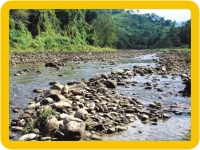
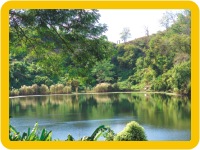

away
from dhaka
closetonature
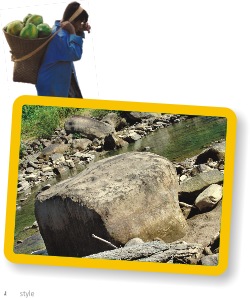 WINTER
is the perfect time for pleasure trips. The word 'pleasure trip' brings
to mind luxurious hotels, beaches and picnic spots with all the delectable
food and lavish facilities handy. Rarely do we set foot for an adventurous
expedition to the places unknown, trekking in the hills or a voyage
in the bottomless sea to an almost deserted island. We Bangalees always
tend to play safe.
WINTER
is the perfect time for pleasure trips. The word 'pleasure trip' brings
to mind luxurious hotels, beaches and picnic spots with all the delectable
food and lavish facilities handy. Rarely do we set foot for an adventurous
expedition to the places unknown, trekking in the hills or a voyage
in the bottomless sea to an almost deserted island. We Bangalees always
tend to play safe.
In
this week's issue, we are going on an expedition to unlock the mysteries
of nature. If you are one of those people who have the knack for adventure
and exploring the unknown, come along with us, let loose your wildest
imagination. And also make the most out of your Eid-ul-Azha vacation
this January.
Trekking
trip to Keokradong
The first place we are taking you is to Bandarban, to Mt. Keokradong,
the highest mountain peak of Bangladesh. It is about 4,500 ft high
from the sea level. On the way to the top you will get to see waterfalls,
serene mountain rivers, ripples of the Boga lake and many friendly
Bawm and Tripura faces.
The
trip starts with a bus ride to Bandarban. You can choose between The
S Alam service from Fakirapool or the Dolphin from Kalabagan, and
the fare is Tk 240. Taking the 11pm night coach, you reach the fresh
air of the hilly district by 7 am. This is followed by a rickshaw
ride to Hafezghona and then to Poukkhon chari by 'chader gaari'. This
interesting vehicle will charge Tk50. You can also reserve a jeep
for Tk 1300-1500. These are available near the bus stand.
From
Poukkhon chari you will have to get to Ruma bazaar by trawler, and
you reach there by nightfall. You can either avail one of the several
boarding houses at the bazaar, or if you want a little more comfort,
try and obtain permission from the authorities to stay at the Parbattya
Ancholik Porishad rest house or the Thana rest house. Sleep tight,
for the morrow brings a challenging adventure.
 The
day starts with a hike to the Boga lake. Grab a local guide to take
you on the 3-hour journey through Eden Hill and Jhiri Khaal to the
entrance of the Boga lake. A handful of stores owned by the indigenous
people there will yield simple food like rice, egg, and bananas, to
appease the hunger that's bound to appear after the long hike.
The
day starts with a hike to the Boga lake. Grab a local guide to take
you on the 3-hour journey through Eden Hill and Jhiri Khaal to the
entrance of the Boga lake. A handful of stores owned by the indigenous
people there will yield simple food like rice, egg, and bananas, to
appease the hunger that's bound to appear after the long hike.
After
a little rest, hiking starts again. You will have to go through Boga
khal this time. After Boga khal you start climbing the slopes full
of damp rocks. There are steps hewn into the slopes by the locals,
with bamboo handrails. An undulating path leads you to Boga para,
where you stay the night.
Beside
the lake there are two rest houses both made of bamboo on high platform.
The tranquil night with sparkling stars on the sky and glowing fireflies
in the bushes will mesmerise you. The Boga lake itself is a wonder.
It is situated about 1250 ft above the sea level on top of the hills.
Indigenous people living there worship the lake believing deeply in
its miraculous power of healing. They believe if you toss a coin in
the water and pray, the lake will fulfil your heart's desire.
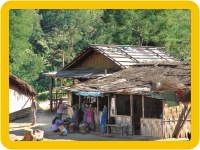 Next
morning the final phase of the journey. After climbing for about two
and half hours you will reach your destination. On the peak, a cascade
of mystic clouds will wash away the polluted spirit of Dhaka's concrete
jungle. Mountain terrain, blurred and embossed in the horizon will
beckon you. They will seem so near yet so far away.
Next
morning the final phase of the journey. After climbing for about two
and half hours you will reach your destination. On the peak, a cascade
of mystic clouds will wash away the polluted spirit of Dhaka's concrete
jungle. Mountain terrain, blurred and embossed in the horizon will
beckon you. They will seem so near yet so far away.
Expedition
to countries largest marshland
If you are not much of a mountain climber then you might like our
next trip, which is to the Tanguar haaor (marshland).
Tanguar
haaor, the biggest in Bangladesh is not yet a popular place among
the tourists. This rich swamp-land, home to a cornucopia of birds,
fish and plant life, is gradually gaining attention. According to
National Conservation Strategy, around 150 under water plants exist
in the marsh. Around 208 species of birds live there. Every winter
thousands of guest birds join the flock.
Tanguar
haaor is situated at Sunamganj districts. It covers about 9700-hectares
of area. Unlike other swamplands, Tanguar haaor is always wet, even
during the dry season in the winter. Rainy season, however, is the
best time to visit.
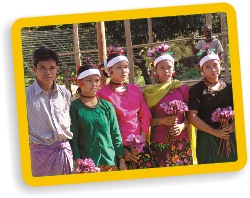 A
bus ride will take you to Sunamganj via Sylhet. Buses start from Sayedabad
bus terminal. One can also go by train via Sylhet. After a night stay
at Sunamganj you can start in the morning. There are moderate hotels
in the town. To visit the haaor you should start early in the morning.
On the way you will see the beautiful Shurma and Jadukata rivers and
magnificent hilly ranges.
A
bus ride will take you to Sunamganj via Sylhet. Buses start from Sayedabad
bus terminal. One can also go by train via Sylhet. After a night stay
at Sunamganj you can start in the morning. There are moderate hotels
in the town. To visit the haaor you should start early in the morning.
On the way you will see the beautiful Shurma and Jadukata rivers and
magnificent hilly ranges.
You
reach Sripur bazaarm and from there you take an engine boat locally
known as tempo-trawler. Upon your arrival at the Paatnai river, you
are greeted by birdsong and emerald green Hijol and Koroch trees.
The Paatnai has several tributaries: you can follow any one of them.
In the shallow waters you will see fishes playing around. Hundreds
of white herons will fascinate you. This place is best for bird watching.
This is the closest you can get to nature. To get back you must reach
Sripur by 3pm and follow the same route home.
A
voyage to Nijhum dweep
Long way from Dhaka, surrounded by the blue waters of Bay of Bengal
rests the mysterious Nijhum dweep (island). It is originally a cluster
of islands, mainly Ballar Char, Kamlar Char, Char Osman and Char Muri,
with a total landmass of about 14050 acres. The island first emerged
in the early 1950s in the south of Noakhali. A group of fisherman
first discovered the island or rather sandbanks. They named it Baular
Char, literally meaning 'the alluvium of sand'. More such sandbanks
were discovered afterwards. The name gradually changed in to current
Ballar Char.
The
island is very lightly populated. Migration started during the 1970s.
In 2001, it was around 10,670. Fishing is the main occupation of these
people. Some are involved in agriculture and livestock farming. Although
life in the island is still full of calamities more people are gradually
migrating there.
This
place is yet isolated from the mainland. It has only six bazaars with
mainly grocery shops, small restaurants and drug stores. These bazaars
are the only places in the island to have electricity supplied by
generators.
You
will get to see mangrove forest and various species of deer in the
island. The forest department created mangrove forests in Nijhum Dweep.
The island is being used as a breeding ground for deer. A herd of
about 5000 spotted deer reigns the island. Explore in and around and
you will discover Keora trees with monkeys swinging in their branches.
Keora is found in the Sundarbans and it has fast growing roots. These
roots were planted to prevent the sandy land from erosion. During
winter, thousands of migratory birds visit the islands enhancing the
splendour even further. If you visit the central coasts you will be
lucky enough to witness the habitat of various birds like waders,
gulls, terns, egrets, ducks and geese. These are the most common species
living there. Some rare species from all around the world pay visit
during October and return in April. Spotted Green Shank, Spotted Red
Shank, Spoon-billed Sandpiper, Indian Skimmer, Sandpiper, Wagtail,
and Brown-headed Gull are a few of them.
The
best time to visit the island is winter. Going to the island will
probably be the most difficult trip you have ever made. You can go
to this island either from Dhaka or from Chittagong. From Dhaka, you
can go to Tomzuddin of Hatia dweep by launch plying from Sadarghat.
From there you can go to Nijhum island by local motorboat. Or you
can take a bus or train ride to Chittagong. From Chittagong you can
go to Hatia island by motor boat or ship known as 'sea truck' and
from there you can go to Nijhum island by local motor boat. Either
way you will have to stay overnight at Hatia. There are some boarding
hotels, among them, the best is Monir Chairman's Boarding. In Hatia,
you will have to go to Jahazmara bazaar by tempo or jeep. From there
you can go to Amtali ghat or Katakhali ghat by rickshaw. Engine boats
are available there to take you to Nijhum dweep. These boats ply depending
on the wave and tide of sea.
If
you wish to stay in the island then you will have to endure very poor
accommodation, which is also very limited. There are some boarding
houses you can stay in. Forest Department has a rest house in the
island. If you can arrange prior permission you can stay there.
There
is also a District Parishod Guest house also requires permission from
the office of the TNO, situated at Hatia. Both these places provide
food.
If
you are travelling in a group, and living in one of the boarding houses
arrange for a cook and prepare the food. You can also eat at local
restaurants but at your own risk of course.
Nijhum
dweep was declared a National Park in 2001. For the adventure seekers
a trip to this island could be the experience of a lifetime.
Let
tour operators handle the odds
You can either take all the hassle to arrange the trip yourself or
hire a tour operator to do to odds. Most tour operators do not have
regular adventure trips to these places, as these are not popular
among tourists. The only operator who will do the job regularly is
Tour Zone, situated at 81/A, Kakrail. Their phone no is 9355781. For
a six-day trip to Keokaradong they charge tk4500 per person. They
have their own guide Laram Bawm for the trip. Laram Bawm lives in
Boga lake para and knows every curve and slope perfectly. A three-day
trip to Tanguar haaor would cost tk2300, and a six-day trip to Nijhum
dweep cost tk3200. This charge includes all transport, all meals,
accommodations, guide service and first aid. They also have video
camera service. If you don't have one of your own, for a tk500 charge
they will lend in theirs. Three to seven days after the tour they
will hand over a CD full of fresh memories.
Among
others operators, Guide Tours occasionally arrange Keokaradong trip
on request only. Their address is Darpan Complex, plot no 2, Gulshan
2. Phone no 9886983.
By
Shahnaz Parveen
Photo: Safayat Hossain Nahid
(If
we have missed the names of any other tour operators offering these
trips please e-mail us the details so that we can update the readers.)

